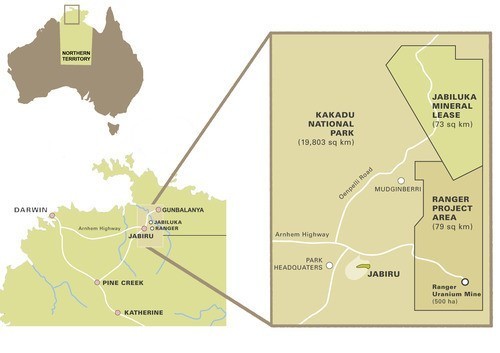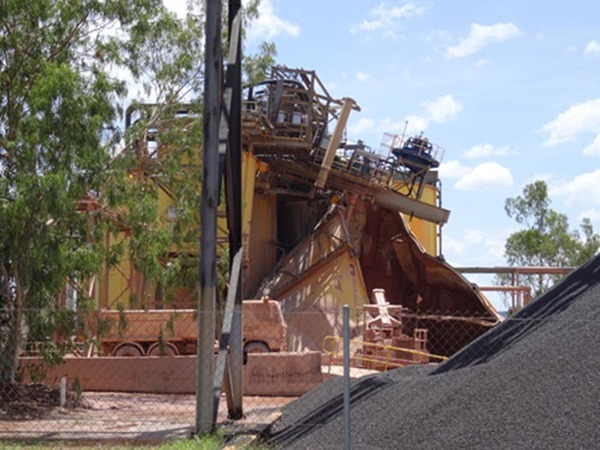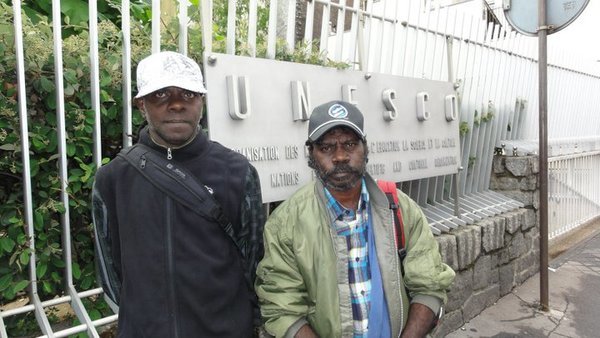Three uranium deposits - Ranger, Jabiluka and Koongarra – were never included in the Park's original boundaries.

Map courtesy of Energy Resources of Australia
Uranium mining was imposed on the Mirarr in the late 1970s and people would still prefer it had never come to their country.
Senior Traditional Owner Yvonne Margarula says that with mining: "The promises never last but the problems always do".
To convey a sense of the Mirarr's experience of imposed uranium mining, Gundjeihmi - in partnership with our colleagues at the Environment Centre NT - created Dirt Cheap 30 years on : the story of uranium mining in Kakadu .
The film includes rare footage (from the original 1980 film Dirt Cheap) of Mirarr Senior Traditional Owner Toby Gangale stating clear opposition to mining on his country. It also documents his prescient concerns about uranium. Dirt Cheap 30 years on shows how the Australian Federal Government overrode the human rights of Kakadu's Traditional Owners in order to impose a toxic industry in a World Heritage Area.
Ranger
As is documented in Dirt Cheap 30 years on Yvonne Margarula’s father - the then Mirarr Senior Traditional Owner Toby Gangale - opposed plans for uranium exploration and mining on his country in the 1970s. His opposition, along with that of other local Aboriginal people, was overruled by the Federal Government when it legislated for the development of the Ranger Uranium Mine in 1976. Ranger commenced operations in 1980, the mine is now run by Energy Resources Australia (ERA) which is majority owned by Rio Tinto.
Since the early 1980s yellowcake from Mirarr land has been sent to fuel nuclear reactors in Japan, Europe and elsewhere.
As traditional landowners, the Mirarr bear responsibility for the impacts that activity on their land has on others. The possibility of uranium from Mirarr land being incorporated into a nuclear weapon or present at the site of a nuclear accident is therefore of enormous concern to Mirarr. Despite assurances from successive Federal Governments that Australian uranium is only sold for nuclear power, the fact remains that is impossible to guarantee Australian uranium does not end up in nuclear weapons.
In April 2011, following the earthquake, tsunami and subsequent nuclear disaster in Japan, Yvonne Margarula wrote to UN Secretary-General Ban ki-Moon and expressed her sorrow at the impacts radiation is having on the lives of Japanese people. She noted that, ‘it is likely that the radiation problems at Fukushima are, at least in part, fuelled by uranium derived from our traditional lands. This makes us feel very sad.’ It has since been confirmed by Dr Robert Floyd, Director General of the Australian Safeguards and Non-Proliferation Office of the Department of Foreign Affairs and Trade, that, “Australian obligated nuclear material was at the Fukushima Daiichi site”.
Ranger uranium mine is now coming to the end of its life. Mining has concluded and minimal processing of stockpiled ore continues as the company contemplates the enormous rehabilitation task.

A leach tank at Ranger uranium mine collapsed in December 2013 spilling over one million litres of radioactive slurry across the site.
A major concern for Mirarr and other Bininj are the potential negative impacts on human health and the environment from the operations of the Ranger uranium mine.
Over 200 spills, leaks and breaches of licence conditions have occurred in the four decades of the mine's existence.
In 2013, a major accident at Ranger resulted in the spilling of over one million litres of radiactive liquid .
All mining and processing at Ranger must conclude by January 2021. Rio Tinto and ERA then have a five year peroid in which they are required to rehabilitate the site to a standard such that it could be incorporated into the World Heritage listed Kakadu National Park.
It is of the very highest priority for the Mirarr that rehabilitation is undertaken comprehensively and in a way that ensures the Mirarr and the Kakadu region are not left with the toxic legacy that Toby Gangale predicted when he said no to Ranger over four decades ago.
Jabiluka
An ‘agreement’ for a second uranium mine on Mirarr country, at Jabiluka, was concluded in 1982 amid great controversy. The validity of the 1982 agreement is contested by the Mirarr, who maintain it was negotiated under extreme duress.
In the late 1990s ERA attempted to mine Jabiluka and the Mirarr initiated and lead a major national and international campaign against the development. The campaign was run both on environmental grounds as well as in recognition of the rights of the Traditional Owners. The campaign involved an eight-month blockade of the site by over 5000 peaceful protesters, two Federal Parliamentary inquiries, a high-level UNESCO mission to Kakadu, resolutions of the European Parliament and US Congress, significant national and international media coverage, and the receipt of major international awards for Yvonne Margarula and Jacqui Katona in recognition of their role in environmental and cultural protection. To date the Jabiluka uranium deposit has not been mined. Energy Resources of Australia has rehabilitated the site in consultation with the Mirarr.
In 2005 the Mirarr and ERA (now owned by Rio Tinto) entered into an agreement that quarantined the Jabiluka dispute by stating that mining may only proceed with the written consent of the Mirarr Traditional Owners. In doing so, Rio Tinto has given meaningful effect to policies of corporate social responsibility especially with respect to the rights of Indigenous peoples.
Over the years of the Jabiluka campaign the Mirarr remained firm in their resistance to unwanted development despite persistent pressure and confidence from the government and mining company that a mine at Jabiluka was inevitable. In their struggle to protect their country and culture Traditional Owners made it crystal clear that Jabiluka was not a sustainable option for one of the world’s largest resource companies. The outcome at Jabiluka demonstrates the role that Indigenous people everywhere should be able to have in determining what happens to their country and their community.
Watch Pip Starr's documentary of the Jabiluka Blockade "Fight for Country"
Koongarra
Koongarra was one of three uranium deposits (along with Ranger and Jabiluka) excluded from the original Kakadu National Park boundaries. Koongarra lies within the traditional lands of the Djok clan and is a region of approximately 12,000 hectares.
The Koongarra uranium deposit is very close to the world famous Nourlangie rock where thousands of visitors view ancient rock art every year. The area is important in traditional storylines that include the Rainbow Serpent and Lightning Man.
It is also home to an estimated 15,000 tonnes of high grade uranium which the French nuclear and mining giant Areva has been trying to access and develop for several decades.
Jeffrey Lee is the Senior Traditional Owner of the Djok clan and speaks for Koongarra. Jeffrey has long resisted Areva's promises of wealth and remained firm in his commitment to care for the land. In 2010 Jeffrey Lee asked the Federal Government to protect Koongarra once and for all by including it within Kakadu, stating at the time: "When you dig a hole in that country you are killing me. I don't worry about money at all."
The Mirarr have a company clan relationship with the Djok and have supported Jeffrey in his efforts to protect his country from mining.
Mirarr and GAC staff attended the World Heritage Committee meeting in 2011 with Jeffrey to seek permanent protection for the Koongarra region from the threat of uranium mining.

Jeffrey Lee (R), Senior Traditional Owner of Djok Clan and Stewart Gangale (L), Mirarr Traditional, at UNESCO Headquarters (Paris, 2011)
The Federal Government promised to honour Jeffrey Lee's wishes and in February 2013 Koongarra was finally included into the World Heritage listed Kakadu National Park.
The area is now permanently protected from uranium mining and included within the National Park.
Read more about Jeffrey Lee's succesful campaign to protect his country from uranium mining.
Watch Jeffrey Lee talking about his efforts to protect his country from uranium mining.
